Evaluation Models Class 10 Notes – The CBSE has changed the syllabus of Std. X. The new notes are made based on the new syllabus and based on the New CBSE textbook. All the important Information are taken from the Artificial Intelligence Class X Textbook Based on CBSE Board Pattern.

Evaluation Models Class 10 Notes
What is evaluation?
Model evaluation is the process of using different evaluation metrics to understand a machine learning model’s performance. An AI model gets better with constructive feedback, you build a model, get feedback from metrics, make improvements and continue until you achieve a desirable accuracy.

What is Evaluating Models?
The evaluation process uses different evaluation metrics to understand a machine learning model’s performance, strengths, and weaknesses. Evaluation is the process of understanding the reliability of any AI model, based on outputs by feeding test dataset into the model and comparing with actual answers. There can be different Evaluation techniques, depending on the type and purpose of the model.
Why we need evaluation model?
Evaluation models are methods for evaluating and choosing the best model during the modeling process. The model evaluation is like giving your AI model a report card. It helps you understand its strengths, weaknesses, and suitability for the task at hand. This feedback loop is essential for building trustworthy and reliable AI systems.
Splitting the training set data for Evaluation
The train-test split is a technique for evaluating the performance of a machine learning algorithm. It can be used for any supervised learning algorithm. The evaluation model divides the dataset into a training set and a testing set.
Why we need of Train-test split?
The train dataset is used to make the model learn, the input elements of the test dataset are provided to the trained model. The model makes predictions, and the predicted values are compared to the expected values. The objective is to estimate the performance of the machine learning model on new data: data not used to train the model.
Accuracy and Error
In AI model evaluation accuracy and error are key metrics which helps to understand how well a model performs and identify the areas for improvement. In AI model evaluation, higher accuracy means a model is better, while lower error indicates less mistakes.
- Accuracy – Accuracy is an evaluation metric that allows you to measure the total number of predictions a model gets right. The accuracy of the model and performance of the model is directly proportional, and hence better the performance of the model, the more accurate are the predictions.
- Error – Error can be described as an action that is inaccurate or wrong. In Machine Learning, the error is used to see how accurately our model can predict data it uses to learn new, unseen data. Based on our error, we choose the machine learning model which performs best for a particular dataset.
How to find accuracy of the AI model
To find the accuracy of an AI model, we have to first calculate the percentage of correct predictions made by the testing dataset. The formula to find the accuracy is—
Error = Actual – Predicted
Error Rate = Error / Actual Price
Accuracy = 1 – Error Rate
Accuracy in percentage = Accuracy * 100
Calculate the accuracy of the House Price prediction AI model
| Predicted House Price (USD) | Actual House Price (USD) | Error Abs (Actual-Predicted) | Error Rate (Error/Actual) | Accuracy (1-Error rate) | Accuracy% (Accuracy*100)% |
|---|---|---|---|---|---|
| 391k | 402k | Abs (402k-391k)=11k | 11k/402k=0.027 | 1-0.027= 0.973 | 0.973*100%= 97.3% |
Given values:
- Predicted House Price = 391k
- Actual House Price = 402k
Step 1: Calculate Absolute Error
Error: 402k−391k = 11k
Step 2: Calculate Error Rate
Error Rate: 11 / 402 = 0.0274
Step 3: Calculate Accuracy
Accuracy: 1 – 0.0274 = 0.9726
Step 4: Convert to Percentage
Accuracy in percentage: 0.973 × 100 = 97.3%
Evaluation metrics for classification
What is Classification?
In artificial intelligence classification is a technique that organizes data into categories. It’s a type of machine learning that uses algorithms to sort data into predefined classes. You go to a supermarket and were given two trolleys, in one, you have to place the fruits and vegetables; in the other, you must put the grocery items like bread, oil, egg, etc. So basically, you are classifying the items of the supermarket into two classes:
- fruits and vegetables
- grocery
Classification metrics
Classification metrics are used to evaluate the performance of a classification model in machine learning, or you can say that it is performance measures used to evaluate the effectiveness of the model. It helps to compare between different models and identify the best one.
Different types of classification techniques in AI
Popular metrics used for classification model
- Confusion matrix
- Classification accuracy
- Precision
- Recall
- F1 Score
1. What is confusion matrix?
The confusion matrix is a handy presentation of the accuracy of a model with two or more classes. The confusion matrix comparison between the prediction and reality and can be recorded in what we call the confusion matrix. The confusion matrix allows us to understand the prediction results.
It consists of four values:
- True Positive (TP): Correctly predicted positive cases.
- False Negative (FN): Model predicted negative, but it was actually positive.
- False Positive (FP): Model predicted positive, but it was actually negative.
- True Negative (TN): Correctly predicted negative cases.
Prediction and Reality can be easily mapped together with the help of this confusion matrix.
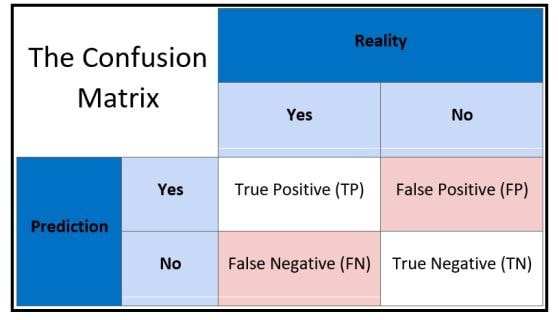
2. Classification accuracy
Classification accuracy allows you to count the total number of accurate predictions made by a model. The accuracy calculation is as follows: How many of the model predictions were accurate will be determined by accuracy. True Positives and True Negatives are what accuracy considers.
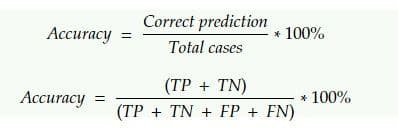
Here, total observations cover all the possible cases of prediction that can be True Positive (TP), True Negative (TN), False Positive (FP) and False Negative (FN).
3. Precision
Precision is defined as the percentage of true positive cases versus all the cases where the prediction is true. That is, it takes into account the True Positives and False Positives.

3. Recall
It can be described as the percentage of positively detected cases that are positive. The scenarios where a fire actually existed in reality but was either correctly or incorrectly recognized by the machine are heavily considered. That is, it takes into account both False Negatives (there was a forest fire but the model didn’t predict it) and True Positives (there was a forest fire in reality and the model anticipated a forest fire).

4. F1 Score
F1 score can be defined as the measure of balance between precision and recall or F1-Score provides a way to combine both precisions and recall into a single measure that captures both properties.

Take a look at the formula and think of when can we get a perfect F1 score?
An ideal situation would be when we have a value of 1 (that is 100%) for both Precision and Recall. In that case, the F1 score would also be an ideal 1 (100%). It is known as the perfect value for F1 Score. As the values of both Precision and Recall ranges from 0 to 1, the F1 score also ranges from 0 to 1.
Let us explore the variations we can have in the F1 Score:

How to draw the confusion matrix
Let’s see one question
Draw the confusion matrix for the following data
- the number of true positive = 100
- the number of true negative 47
- the number of false positive = 62
- the number of false negative = 290
Answer:
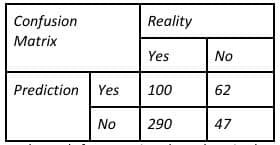
Build the confusion matrix from scratch
Let’s assume we were predicting the presence of a disease; for example, “yes” would mean they have the disease, and “no” would mean they don’t have the disease. So, the AI model will have output is Yes or No
| Actual | Predicted |
|---|---|
| Yes | Yes |
| No | No |
| Yes | No |
| No | Yes |
| Yes | Yes |
| Yes | No |
| No | No |
| Yes | Yes |
| No | Yes |
| Yes | Yes |
Now, count each type of prediction:
TP (Yes, Yes) = 4
FN (Yes, No) = 2
FP (No, Yes) = 2
TN (No, No) = 2
The matrix based on the table given here
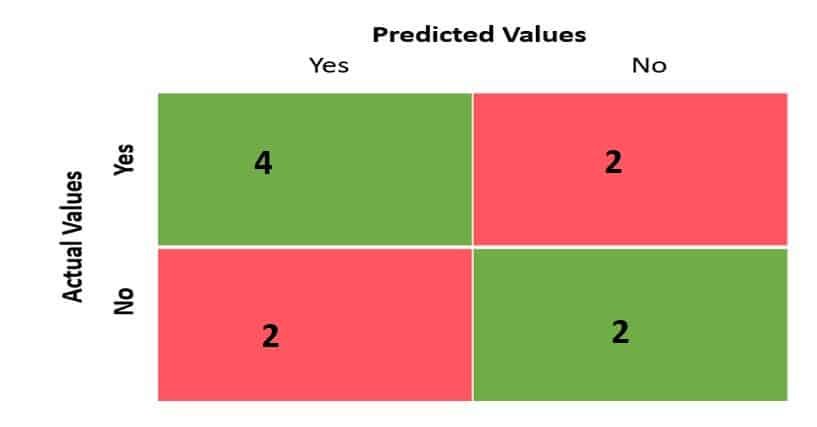
let’s find the accuracy:
Accuracy = (TP + TN) / Total Predictions
= (4+2) / 10
=6 / 10
= 0.6
The model correctly predicted 6 out of 10 cases, meaning the accuracy is 60%
Can we use Accuracy all the time?
It is only suitable when there are an equal number of observations in each class, i.e., a balanced dataset (which is rarely the case), and that all predictions and prediction errors are equally important, which is often not the case.
Classification Accuracy Calculation
Let’s assume you are testing your model on 1000 total test data. Out of which the actual values are 900 Yes and only 100 No (Unbalanced dataset). Let’s assume that you have built a faulty model which, irrespective of any input, will give a prediction as Yes.
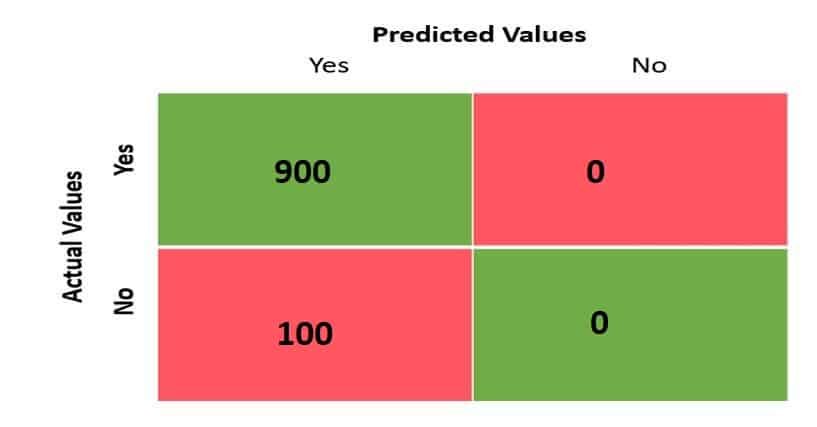
True Positives (TP) = 900
False Negatives (FN) = 0
False Positives (FP) = 100
True Negatives (TN) = 0
Now, applying the formula:
Accuracy = (TP + TN) / (TP + TN + FP + FN)
= (900 + 0) / (900 + 0 + 100 + 0)
= 900 / 1000
= 0.9
Accuracy = 0.9 x 100 = 90%
Now the model is 90% accurate; it is misleading because it never predicts “no.” We should use precision, recall, and F1 score to get better evaluation.
Calculate the accuracy of the classifier model using precision, recall and F1 score
Let’s see on example,
Question: An AI model made the following sales prediction for a new mobile phone which they have recently launched:

- Identify the total number of wrong predictions made by the model.
- Calculate precision, recall and F1 Score.
Answer:
(i) the total number of wrong predictions made by the model is the sum of false positive and false negative.
FP+FN=0+100= 100
(ii) Before calculating, we will first see the formulas for precision, recall, and F1 score.

Precision=TP/(TP+FP)
=900/(900+0)
=(900/900)*100
=1.0
Recall=TP/(TP+FN)
=900/(900+100)
=900/1000
=.0.9
F1 Score = 2 * Precision * Recall / ( Precision + Recall )
=2 * 1.0 * 0.9 / (1.0+0.9)
=2 * 0.4737
=0.947
previously we get 90% accurate but now the accuracy of the model is 94.7%.
Let’s see one another example,
Question: An AI model made the following sales prediction for a new mobile phone which they have recently launched:

- Identify the total number of wrong predictions made by the model.
- Calculate precision, recall and F1 Score.
Answer:
(i) the total number of wrong predictions made by the model is the sum of false positive and false negative.
FP+FN=40+12= 52
(ii) Before calculating, we will first see the formulas for precision, recall, and F1 score.

Precision=TP/(TP+FP)
=50/(50+40)
=(50/90)*100
=0.55
Recall=TP/(TP+FN)
=50/(50+12)
=50/62
=.81
F1 Score = 2 * Precision * Recall / ( Precision + Recall )
=2 * 0.55 * .81 / (.55+.81)
=.891 / 1.36
=0.65
Which metric is appropriate to evaluate the AI model?
Let’s compare which matrix is important for finding accuracy.
| Metric | Use Case | When to Choose It | Suitability for This Model |
|---|---|---|---|
| Accuracy | General performance | When classes are balanced | Not suitable |
| Precision | Minimize false positives | Spam detection, Fraud detection | Suitable |
| Recall | Minimize false negatives | Medical diagnosis, Safety alerts | Suitable |
| F1-Score | Balance in precision & recall | When both FP & FN are important | Best choice for overall performance |
The F1-score (65.76%) is the most appropriate evaluation metric for this AI model.
Ethical concerns around model evaluation
Ethical concerns around model evaluation primarily focus on three aspects: bias, transparency, and accuracy. Nowadays, we are moving from the Information era to the Artificial Intelligence era. Now we do not use data or information, but the intelligence collected from the data to build solutions. We need to keep aspects relating to ethical practices in mind while developing solutions using AI. Let us understand some of the ethical concerns in detail.
- Bias – Bias occurs when a model generates unfair or discriminatory results. This can happen due to the model favoring certain groups or due to the algorithm. For example, if the AI application of Amazon is favoring male candidates only, then the maximum product suggestion will be shown only to male candidates, which will decrease the profit of the company.
- Transparency – The AI decision-making process should be transparent; people can easily understand and interpret the result. If the lack of transparency issue is there, then the people will not trust the model. For example, if any person has applied for a loan and the AI model denies a loan application of any candidate, then it is the duty of the AI that the applicant should know why the loan application is rejected.
- Accuracy – The AI model should predict the correct result. The accurate model makes error-free and reliable results. For example, in medicine, an AI model should diagnose and generate accurate predictions; otherwise, due to wrong diagnoses, it can lead to a serious illness in the people.
Disclaimer: We have taken an effort to provide you with the accurate handout of “Evaluation Models Class 10 Notes“. If you feel that there is any error or mistake, please contact me at anuraganand2017@gmail.com. The above CBSE study material present on our websites is for education purpose, not our copyrights. All the above content and Screenshot are taken from Artificial Intelligence Class 10 CBSE Textbook and Support Material which is present in CBSEACADEMIC website, This Textbook and Support Material are legally copyright by Central Board of Secondary Education. We are only providing a medium and helping the students to improve the performances in the examination.
Images and content shown above are the property of individual organizations and are used here for reference purposes only.
For more information, refer to the official CBSE textbooks available at cbseacademic.nic.in
